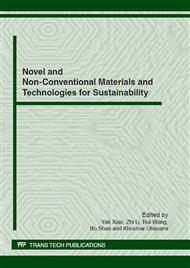p.617
p.622
p.628
p.635
p.646
p.653
p.661
p.669
p.677
Study of EVA Blocks Waste Recyclability
Abstract:
The use of EVA (Ethylene Vinyl Acetate) waste, from shoes industry, in the production of pre-molded block (EVA block) has been researched in the last 12 years. The results have shown great potential for these wastes to be used as lightweight aggregate, to replace natural aggregate in the manufacture of bricks made of cement based composites. This article examines the potentiality of waste EVA blocks recyclability, as aggregate in the production of new EVA blocks. In the experiment EVA blocks were molded in the mix proportion of 1:5 in volume (20% of sand and 80% of EVA) and determined the mass and compressive strength at 28 days. Then the EVA blocks were crushed and resulting aggregate was reused in part (portion retained on a 4.8 mm sieve) in the molding of new EVA blocks, using in dosages two different proportions of crushed aggregate (50% and 70%, EVAr - waste of crushed EVA blocks) in relation to the total volume of coarse aggregate of original EVA (EVA - waste from shoes industry). The average compressive strength at 28 days of the original EVA block was 1.2 MPa, whereas the block EVAr70 was 2.2 MPa and the block EVAr50 was 1.7 MPa. Thus, there was an 83% increase in the compressive strength on the block EVAr70 and 44% on the block EVAr50. It was also noticed there was no significant difference among the weights of all the blocks produced. So, it appears that the EVAr aggregate impacted more in the compressive strength than in the mass of the blocks. Thus, the recyclability of the EVA block appears viable.
Info:
Periodical:
Pages:
646-652
Citation:
Online since:
June 2012
Price:
Сopyright:
© 2012 Trans Tech Publications Ltd. All Rights Reserved
Share:
Citation:


